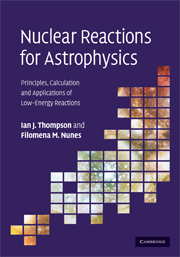Book contents
- Frontmatter
- Contents
- Preface
- Sources of quotations
- Acknowledgements
- 1 Nuclei in the Cosmos
- 2 Reactions of nuclei
- 3 Scattering theory
- 4 Reaction mechanisms
- 5 Connecting structure with reactions
- 6 Solving the equations
- 7 Approximate solutions
- 8 Breakup
- 9 Three-body nuclei
- 10 R-matrix phenomenology
- 11 Compound-nucleus averaging
- 12 Stellar reaction rates and networks
- 13 Connection to experiments
- 14 Spectroscopy
- 15 Fitting data
- Appendix A Symbols
- Appendix B Getting started with Fresco
- Select bibliography
- Index
15 - Fitting data
Published online by Cambridge University Press: 05 March 2012
- Frontmatter
- Contents
- Preface
- Sources of quotations
- Acknowledgements
- 1 Nuclei in the Cosmos
- 2 Reactions of nuclei
- 3 Scattering theory
- 4 Reaction mechanisms
- 5 Connecting structure with reactions
- 6 Solving the equations
- 7 Approximate solutions
- 8 Breakup
- 9 Three-body nuclei
- 10 R-matrix phenomenology
- 11 Compound-nucleus averaging
- 12 Stellar reaction rates and networks
- 13 Connection to experiments
- 14 Spectroscopy
- 15 Fitting data
- Appendix A Symbols
- Appendix B Getting started with Fresco
- Select bibliography
- Index
Summary
An approximate answer to the right problem is worth a good deal more than an exact answer to an approximate problem.
John TukeyGiven the R-matrix, DWBAor coupled-channels theories of the previous chapters, we now discuss how to vary any unknown parameters to fit experimental measurements. The fitting parameters of a reaction model could be those which specify Woods-Saxon potentials, or they could be structural parameters such as deformations or spectroscopic factors. Sometimes the parameters linearly determine the model predictions (such as spectroscopic factors in one-step DWBA), but more often the predictions depend non-linearly on the model parameters (especially those defining the potentials). When there are multiple non-linear parameters, more systematic methods are needed.
Data fitting is thus the systematic variation of the parameters pj(j = 1, …, P) of a theory in order to find a parameter combination which minimizes the discrepancies with experiment. This is most commonly done by minimizing the χ2 measure of these differences, as defined below, and in Section 15.5 we discuss strategies for this minimization.
χ2measures
Specifications
We want to compare theoretical with experimental cross sections, and use this comparison to improve the theory input parameters {pj} so that observed and predicted cross sections agree better.
- Type
- Chapter
- Information
- Nuclear Reactions for AstrophysicsPrinciples, Calculation and Applications of Low-Energy Reactions, pp. 403 - 418Publisher: Cambridge University PressPrint publication year: 2009



